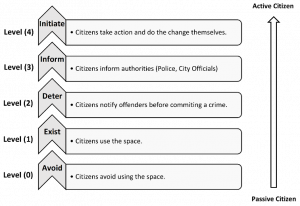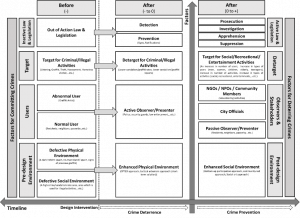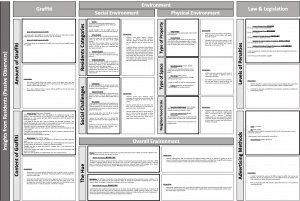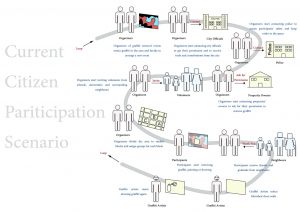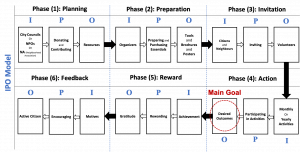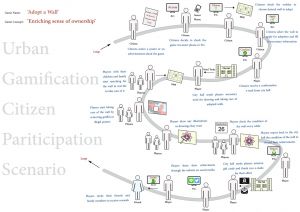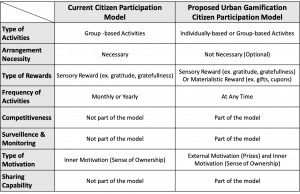Using Urban Gamification to Promote Citizen Participation for Designing Out Graffiti in Public Spaces
Ahmed Mohammed Sayed MOHAMMED
Department of Design Strategy, Graduate School of Design, Kyushu University
Yasuyuki HIRAI Department of Design Strategy, Graduate School of Design, Kyushu University
Keywords: Urban Design, Gamification, Citizen Participation, Designing Out Crime
- Abstract
- Graffiti is considered as one of the most common types of vandalism worldwide, as it threatens not only our public and private properties, but also our social environment. Moreover, Graffiti has proven to encourage more different types of vandalism, as it is considered as a broken window that causes more disorder in public spaces. In order to solve this problem, this research examines current citizen participation model adopted by different neighbourhood associations and NPOs in Fukuoka City to encourage citizens to be part of the solution. Then, a new model is proposed based on urban gamification as a hybrid citizen participation strategy to encourage more citizens to act as passive observers in public spaces. The proposed model is based on different interviews conducted with citizens of Fukuoka City to make sure that their desires and aspirations are met. This research concluded that current adopted citizen participation model is not sustainable enough making it difficult to fight against a vital problem such as graffiti, and the proposed model has the potentials to encourage more citizens to act more actively in a sustainable way.
目次
Research Goal and Background
According to (Davey and Wootton 2017)[1], individuals can act as observers or preventers in public spaces. Observers in public spaces are divided into two different types: active observers and passive observers. Active observers could be police officers, security guards or anyone whose job is to keep order in the space and support its human function. Passive observers could be normal users of the space, passers-by, citizens or neighbours. Therefore, citizens who would act as passive observers have responsibility towards safety in public spaces. Based on the natural surveillance concept mentioned by (Newman 1972)[2] and based on the crime life cycle model (Davey and Wootton 2010)[3], There are five different levels for citizens to be involved in crime prevention in public spaces, citizens either avoid (Level 0) spaces with poor physical environments or exist (Level 1) in better ones. Once citizens use public spaces, they could deter (Level 2) offenders, inform (Level 3) authorities or initiate (Level 4) the change by themselves [Figure 1].
Citizens from level 0 to level 1 are considered as passive citizens, but citizens in level 2 to level 4 are considered as more active ones. In order to motivate citizens, gamification has been approached as a citizen participation strategy that brings game elements to non-game contexts in public spaces which motivates citizens to act more actively (Deterding et al. 2011)[4]. Gamification has proven to be effective in promoting citizen participation which encourages citizens to change their behaviour in a more vigorous way (August Gade Johansen and Camilla Bech Pedersen 2019; Bianchini, Fogli, and Ragazzi 2016; Thiel 2016)[5] [6] [7]. The main purpose of this research is to reach an understanding of how urban gamification approach could make difference for Fukuoka City Citizens to deter, inform or act against graffiti creating safer public spaces.
Research Method
Literature survey is done to understand different factors of committing crimes in public spaces and to review graffiti effect on users’ behaviour and public manner. Then, different public spaces design case studies have been collected and analysed based on criteria derived from the basic crime triangle (Felson and Clarke 1998)[8] and the work of (Davey and Wootton 2017), and four different factors of committing crimes in public spaces were identified. These factors are the target, law & legislation, environment and users and stakeholders [Figure 2].
Based on these four different factors, questionnaires and interviews have been conducted with a graffiti artist, Fukuoka City citizens, Fukuoka City Officials, neighbourhood association and NPOs. From this field research, current citizen participation model adopted by different neighbourhood associations and NPOs in Fukuoka City have been understood and citizens’ desires and aspirations have been illustrated. On the other hand, different urban gamification case studies have been collected to reach an understanding of how users’ behaviour change along the process and how gamification works regarding encouraging citizen participation. Based on this analysis and citizens’ desires and aspirations, a new model has been proposed to encourage citizen to be more active in public spaces.
Results
Different motives and desires have been grasped from the field research. Graffiti artist has explained that graffiti writers do graffiti because of their strong desire to show their styles, techniques and talent to everyone and streets are their free exhibition. Graffiti writers also keep doing graffiti despite the risk they face because of the feedback they receive in form of respect from other artists in the community beside their feeling of being courageous to do something only few people can do. On the other hand, Fukuoka City citizens found to be less willing to be involved in fighting against graffiti, as the online questionnaire has shown that 27% of the respondents are willing to deter offenders, 20% of the respondents are willing to inform authorities and 0% of the respondents are willing to take part in any social activities [Figure 3].
Moreover, in-depths interviews with citizens have shown that different types of citizens have different desires to be more willing to get involved. Interviews with mothers in households have shown that families would be more willing to participate, if conducted activities ensure that their children would have fun, or those activities are conducted to save teenagers from getting involved in any illegal activities in a young age. Interviews with people who live alone have shown that they are not willing to participate because of their fear of crime and social anxiety, as they live alone and could be in risk if they take part in public activities. Interviews with university students and high school students have shown that they are willing to be involved, if they participate with their friends and club members. Insights and notes retrieved from the online questionnaire and in-depth interviews with citizens are shown in figure [4].
Furthermore, Interview with Crime prevention and Road Safety Bureau in Fukuoka City has shown that Fukuoka City wants to improve citizens’ public manners that’s why they initiated “Graffiti Removal initiative” to encourage citizens to take part in the removal process by giving them free tools and materials. Interview with other stakeholders such as the neighbourhood associations in the downtown of Tenjin area in Fukuoka city and Lions International Club have shown that current citizen participation model has its pros and cons. One of the positive outcomes is that current citizen participation model helps to build stronger connections and social cohesion between different stakeholders, community members and police, however it is considered as painkiller solution, as it is not sustainable enough to fight against a vital threat such as graffiti and a more sustainable solution is needed.
Discussion
Volunteering activities conducted by neighbourhood associations and NPOs found to have a long process that requires a lot of arrangement. That makes these kinds of activities not sustainable enough to depend on solitary. On the other hand, these activities require a lot of effort from organizers to invite citizens, police, city officials and neighbours to participate [Figure 5]. Moreover, based on the field research, motives that drive participants to participate in these kinds of activities are usually derived from the feeling of gratitude that participants receive from surrounding neighbours. This found to be not encouraging enough for other citizens who have other motives such as mothers who just need to participate in activities that brings joy to their children. Thus, we can conclude that current citizen participation model would be suitable for already active citizens, but not for passive ones [Figure 6]. Therefore, urban gamification has been evaluated as a new approach of citizen participation that works on motivating citizens by introducing game elements and techniques to non-game contexts like public spaces.
Moreover, a comparison has been conducted between traditional citizen participation strategies adopted by neighbourhood associations and NPOs and advanced citizen participation strategies such as gamification, this comparison was done based on the work of (August Gade Johansen and Camilla Bech Pedersen 2019; Carver 2003; Masser and Mory 2018)[9] [10]. Form this comparison different potential benefits have been noted from using gamification as an advanced citizen participation strategy to encourage citizens to be more active in public spaces. First, traditional citizen participation activities are usually available at a specific date, time and location compared to advanced strategies such as gamification which is available all the time everywhere possible making it more convenient for citizens to participate. Second, as mentioned earlier, feedback received from traditional citizen participation strategies is limited to the sense of gratitude and appreciation form neighbours and organizers, but using gamification allows more different types of feedback such as gifts, prizes or points. Third, traditional citizen participation needs to be done in groups with enough participants to make it happen compared to gamification which can allow for both group based activities and individual based ones making it more suitable for individuals who could hesitate to participate because of their feeling of social anxiety or getting in contact with strangers. Therefore, gamification has been chosen as an advanced citizen participation strategy that could encourage citizens to be more involved in standing against graffiti [Figure 7].
Based on the analysis of different case studies, urban gamification found to have a hybrid style which consists of an online (off site) phase and an offline (on site) phase. Urban game developers implement different triggers in the online phase to attract citizens and encourage them to play by using attractive interface design and personalised communication design. Then, players move to the location of the activity in the urban space to achieve the goal of the game. At last, the game rewards players for participating by either a materialistic reward (ex. Prizes, gifts, …etc.) or a sensory feedback (ex. Appreciation, gratitude, sense of achievement, …etc.). In order to keep players participating, game developers keep adding new updates and levels to keep citizens engaged in the process. By adopting the same structure of urban gamification in designing new graffiti removal activities that would keep citizens engaged and ready to devote part of their time to be more responsible in public spaces [Figure 8].
Conclusion
This research has shown the damaging effect of graffiti on the environment and public manners which makes it essential for citizens to be part of the solution. By examining efforts adopted by different neighbourhood associations and NPOs in Fukuoka City to encourage citizen to take action, these efforts found to be effective, but not long lasting which makes it not sustainable enough. A more comprehensive sustainable solution is needed to encourage individuals to act as passive observers in public spaces. Thus, urban gamification approach has been evaluated to create a new model of citizen participation [Table 1]. The proposed model could be considered as a guide for urban planners, city councils, neighbourhood associations and NPOs to encourage citizens to be part of the solution to fight against graffiti and vandalism to keep public spaces safe and secured.
References
- ↑ Davey, Caroline L., and Andrew B. Wootton. 2017. Design against Crime: A Human-Centred Approach to Designing for Safety and Security. Taylor & Francis.
- ↑ Newman, Oscar. 1972. Defensible Space. Macmillan New York.
- ↑ Davey, Caroline L., and Andrew B. Wootton. 2010. “Design+Security & Crime Prevention. Enabling Socially Responsible Design by Embedding Security and Crime Prevention within the Design Process.” Unpublished Report for the UK Design Council, Salford, UK: University of Salford.
- ↑ Deterding, Sebastian, Dan Dixon, Rilla Khaled, and Lennart Nacke. 2011. “From Game Design Elements to Gamefulness: Defining" Gamification".” Pp. 9–15 in Proceedings of the 15th international academic MindTrek conference: Envisioning future media environments.
- ↑ August Gade Johansen, and Camilla Bech Pedersen. 2019. “Gamified Participation: Challenging the Current Participation Methods in Urban Development with Minecraft.” Institute of Architecture & Design, Aalborg University.
- ↑ Bianchini, Devis, Daniela Fogli, and Davide Ragazzi. 2016. “Promoting Citizen Participation through Gamification.” Pp. 1–4 in Proceedings of the 9th Nordic Conference on Human-Computer Interaction.
- ↑ Thiel, Sarah-Kristin. 2016. “Reward-Based vs. Social Gamification: Exploring Effectiveness of Gamefulness in Public Participation.” Pp. 1–6 in Proceedings of the 9th Nordic Conference on Human-Computer Interaction.
- ↑ Felson, Marcus, and Ronald v Clarke. 1998. “Opportunity Makes the Thief.” Police Research Series, Paper 98:1–36.
- ↑ Carver, Steve. 2003. “The Future of Participatory Approaches Using Geographic Information: Developing a Research Agenda for the 21st Century.” Urisa Journal 15(1):61–71.
- ↑ Masser, Kai, and Linda Mory. 2018. The Gamification of Citizens’ Participation in Policymaking. Springer.
